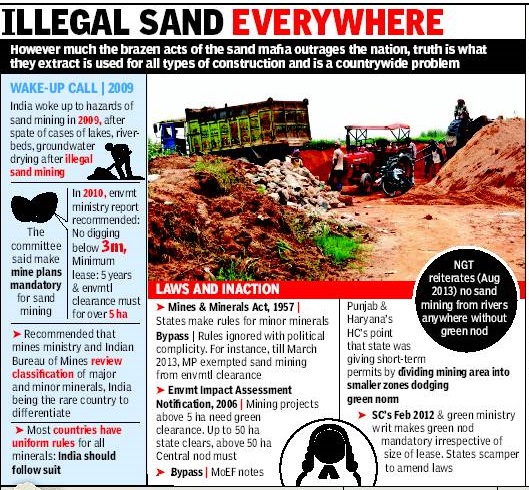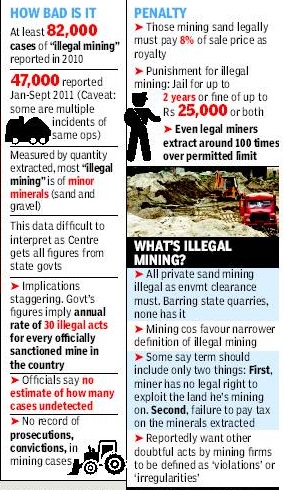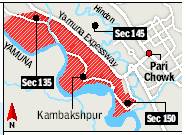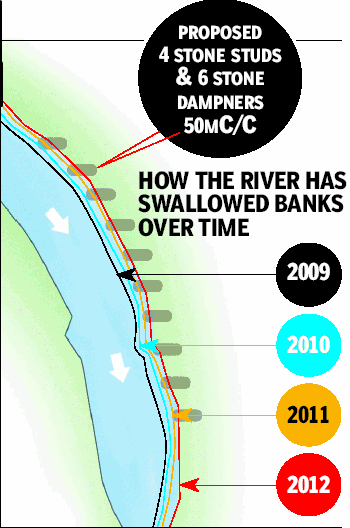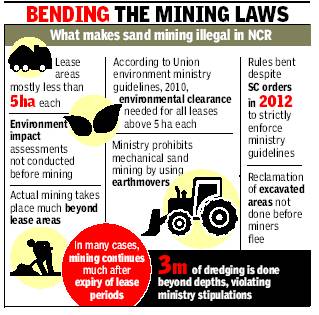Sand mining: India
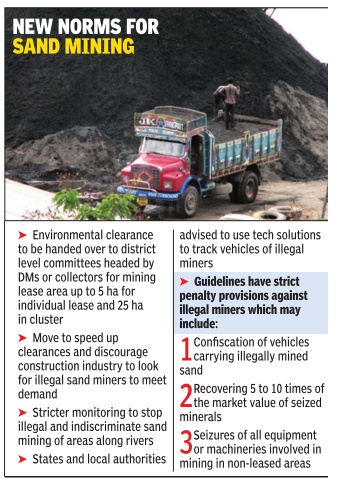
This is a collection of articles archived for the excellence of their content. Readers will be able to edit existing articles and post new articles directly |
The economics of illegal sand mining
Nagpal crackdown cost sand mafia 500cr
9L Tonnes Extracted In A Year, Monthly Turnover 100Cr: Sources
Vandana Keelor & Purusharth Aradhak TNN
The Times of India 2013/08/03
Noida/Greater Noida: The boom in construction activity in the NCR, coupled with the lack of alternatives to river sand, has made illegal sand mining a lucrative business here. Trucks illegally enter the river bed, and sand miners have the tacit support of political parties. Scores of dredgers can be seen operating with impunity even as they manage to overcome officials like Durga Sakthi Nagpal, who are few and far between.
Conservative estimates by sources connected to the sand mafia put the quantity of sand illegally extracted in the past one year at nine lakh tonnes, which took about 1.27 lakh trips from Gautam Budh Nagar by bribing cops on the inter-state borders of Delhi, Haryana and UP. Sand has been smuggled mainly out of Noida and Greater Noida, including villages of Gulavli, Kambakspur, Jaganpur, Asgarpur, Afzalpur, Chaproli, Dankaur, Atta Gujaran, Gunpura, Faleda, Tekpur, Shergarh, Nangla Wajidpur, Mehndi and Gharbara.
Sources said 350 trucks or dumpers, including tractortrolleys were involved in the smuggling. “We used to pay Rs 50-100 per vehicle at checkpoints to cross over. Now, the monthly charges have been fixed and we get a free pass,” said a driver. As the returns are high, many trucks can be seen making several trips during the night while the PCR cops look on.
According to sources, Nagpal’s crackdown in the past few months has led to annual losses of Rs 500 crore for the smugglers. More checkpoints were mounted and touch action was being taken against smugglers. “Earlier, smugglers got away by paying a fine. Now, we seize the vehicle and register cases against the vehicle owner,” said a transport official.
If the administration’s estimates are to be believed, this business helps rake in Rs 100 crore in a month. A truckload of sand costs Rs 5,000-6,000, while a tractor-trolley can fetch Rs 2,000-3,000. Sources said during shortfall, a loaded dumper can allow the mafia to make Rs 25,000. The district is able to squeeze only Rs 1 crore as revenue despite intensive drives to clamp down on illegal sand mining. Revenue officials said over Rs 2 crore was recovered as fines in the past year, losses incurred by the revenue department are mounting. Without paying money to mafia, no realtor or mining contractor can start digging on a plot for real estate projects.
The sand mining operation works at several levels. On the top are members of the syndicate, which works as a bridge between the government and the mining mafia. Then there are several independent small-time players who can afford trucks, tractors and excavators, besides those who manage a network of independent operators. Those in the “business” say the unflagging demand for sand and the big money involved propels underhand operations, and at times, triggers attacks on those who complain to authorities. After the clampdown, there is a lull but the activity picks up as fast as it stops, said locals who have seen the plundering of the river bed.
A MURKY BUSINESS
250 to 350 truckloads of sand dredged illegally everyday
Nearly 500 crore worth of sand stolen from the riverbeds every year
Sand sold to real estate projects in Gautam Budh Nagar, Gurgaon, Ghaziabad, Delhi and Faridabad
A truckload of illegal sand costs about 5,000-6,000 while a tractor trolley comes for 2,000-3,000
When sand is in short supply, a dumper could cost up to 25,000
Mining is rampant in villages like Asgarpur, Nangla Wajidpur, Gulavli, Kambakshpur, Jaganpur, and on a nearly 10-km stretch running parallel to Noida-Greater Noida Expressway
Real estate and illegally mined sand
Real estate biz thrives on illegally mined sand
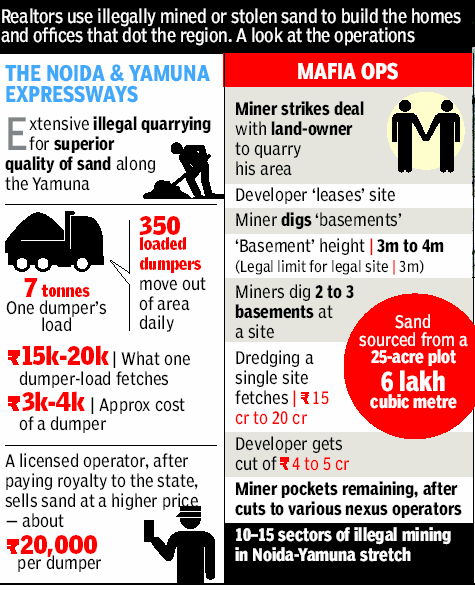
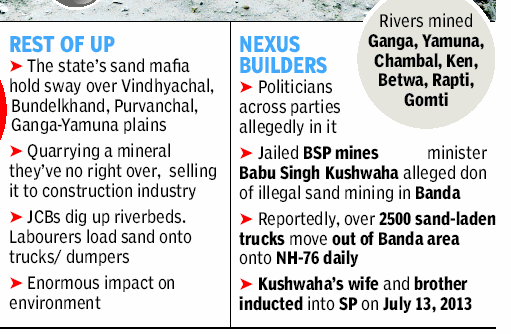
The Times of India 2 Aug 2013
Noida: Although an essential element in construction that determines the overall cost of a real estate project, sand in this region is all mined illegally. There are no licensed miners and there are areas where there’s a blanket ban on sand mining. Yet, all of Noida’s construction projects depend on stolen sand. The real estate industry mostly lends support to sand mining activities in the district.
Developers are always on the lookout for cheap sand. They’re provided this by a mafia network that digs deep into the riverbeds of Hindon and Yamuna in Gautam Budh Nagar. They have no permission, evade royalty and brazenly flout whatever norms exist.
The sand mafia sells the construction material in the range of Rs 6000-20,000 per dumper, depending on the quality of the sand. Trolley rates range between Rs 3,000 and 8,000 again based on quality. There are three gradations to sand, and Noida boasts the top grade.
For a truck of illegal sand, builders pay half the rate they would for a licensed truck-of-sand. “We depend upon vendors and suppliers. The cost of sand is around Rs 12-16 per cubic foot. If procured legally, project costs would shoot up by 10-15%. That’s why we opt for cheaper option,” said a leading developer. The mafia even delivers truckloads at the builder sites but neither government nor police bother to check on how the sand is procured.
Realtors say the mining, though illegal, boosts the ‘development’ engine. “Without this sand, construction would come to a grinding halt,” said a realtor. Another reluctantly concedes that without a regulatory and monitoring framework to dig out the sand, the rush to build factories, high-rises offices, schools and roads, may be taking a toll on the environment. Some are coming around to the view that policy and legal measures to control sand mining must be made more stringent and should be based on environmental concerns.
There are suggestions for replacing sand. “The need of the hour is to find substitutes for sand, such as concrete blocks instead of traditional brickwork, elimination of plaster, etc,” said a builder with several projects in the region.
The economics of sand mining across India
Sand wars: Hundreds have died over mining rights in Bihar
The sand mining business in Rajasthan runs between Rs 300 crore and Rs 400 crore per month. State capital Jaipur is a major demand centre and also serves as a terminal for supply to Delhi, Gurgaon and Behror. In Bihar, a government official estimated the illegal sand mining trade to be worth between Rs 7,000 crore and Rs 8,000 crore.
“Around 1,500 to 2,000 truckloads of river sand is sold in Jaipur every day, while the average for the state is between 8,000 and 9,000 trucks per day,” said Navin Sharma, president of the All Rajasthan Bajari Truck Union. Each truck carries 500 cubic feet bajari, or sand, which costs around Rs 25 to Rs 30 per cubic feet, said Sharma.
The price of a truckload of sand also varies from state to state. A truck load of sand (600 cubic feet) is available for Rs 15,000 in Haryana whereas it was available for Rs 3,500 three years ago when mining was not banned in the state. In West Bengal it varies between Rs 1,600 and Rs 2,000 per truck. But in some cities such as Bangalore it may go up to Rs 40,000 for a truckload of sand depending on the quality.
Sand is a good source of revenue for state governments. According to the commissioner of geology and mining department, Gujarat earned Rs 114 crore royalty from sand mining in 2012-13, up from Rs 102 crore in the last year. The state government charges Rs 12 per tonne royalty on sand.
The huge gap between supply and demand of natural sand has seen an increase in the illegal filter sand business (washing of sandy loam soil and selling it as sand) in the state. The farmers along the riverbeds, tank beds and streams are extracting sand and selling it to the mafia. The farmers extract sand and sell it to the middlemen for Rs 6,000 to Rs 9,000 per truckload, depending on the quality.
The increase in the construction of apartments, townships, roads and bridges has pushed up the demand for sand. “Sand is an expensive commodity today, though the price varies in different markets. Risk factors are many, such as the mounting pressure on the government machinery from the sand mafia and their growing threat,” said a senior officer at Aurangabad.
Soaring demand for sand due to massive construction poses a threat not just to the environment but to society at large, and urgent measures are needed to tackle the problem.
“With real estate mushrooming and construction of highways and roads booming, there is huge demand for sand. And this has led to mafia taking over in many areas,” said Yamuna Jiye Abhiyan’s Manoj Mishra.
In recent years, Bihar has witnessed bloodshed over sand mining rights. Hundreds of people have been killed in ‘sand wars’ between different criminal gangs backed by politicians, especially in sand-rich Lakhisarai, Saran, Bhojpur, Nawada and Patna districts. Killings to get mining rights are commonplace. Rewards include not only the ‘legal earnings’ but also the money made through clandestine mining of sand in excess of the volume permitted by the government.
Apart from the big bucks, the livelihood of hundreds of thousands of people, from truck drivers to construction labourers, are linked to the business. Officials and experts say a clampdown on illegal mining would have a big impact on employment.
In Maharastra sand fetches revenues of approximately Rs 300-400 crore. The total revenue from minor minerals is approximately Rs 1500 crore. Officially blocks are earmarked and then auctioned by the state government after environment clearance is granted. Last year auctions were held in only 26 districts as there is a moratorium on mining in Ratnagiri and Sindhdurga since 2010. “About 4,000 trucks are involved in transport of sand to the construction sites in Pune and Pimpri-Chinchwad areas every day,” said Yogesh Sasane, secretary of the Pune Mining and Crushing Organization.
Any disruption in supply is expected to push up the project costs, give rise to more mafia and cripple building activity. Already builders are facing the heat. The real estate sector is one of the largest employers.
“The cost of sand has gone up three times in the last one year. And today if I ask for quote for sand nobody is willing to give that because of the uncertainty,” said Getambar Anand, president-elect of CREDAI, a builders group. “A blanket ban is not a solution. It leads to black marketing. If it is the failure of enforcing agencies why should we suffer?” Anand said.
(With inputs from Pranava K. Chowdhury in Patna, Saugata Roy in Kolkata, Harit Mehta in Ahmedabad, Anindo Dey in Jaipur, Shiva Kumar ND in Bangalore, Sarang Dastane in Pune, Ranjan Diggikar in Aurangabad, Chennai, Himachal Pradesh, Haryana, Punjab, Goa, Bhopal, Odisha, Clara Lewis in Mumbai)
Realty, Road Booms Spur Big Demand
High stakes, mega bucks fuel illegal ‘dig-load-sell’ sand biz
Surojit Gupta TNN
The Times of India 2013/08/11
New Delhi: The humble sand is today big business. The boom in the construction industry in the last decade has triggered a huge demand for sand, to meet which contractors, with the help of pliant state officials, have begun a dig-load-sell exercise at a frantic pace. The story of illegal loot in this high-stake business, carried out by a growing sand mafia, is repeated in state after state.
TOI spoke to several officials, activists, contractors and dealers to get an estimate of the exact size of the business. But a majority of them said it would be difficult to put a number. Contractors estimate the sand business in Haryana alone at Rs 10,000 crore a year. In Punjab, it is estimated to be a Rs 2 crore a day, while in Odisha it’s pegged around Rs 15,000 crore a year.
“It is very difficult to estimate the actual size of the sand business as this varies from place to place across the country,” said Manoj Mishra, convener of the Yamuna Jiye Abhiyan. Along the Yamuna alone, from Yamunanagar to Etawah, he pointed out, there are “hundreds” of illegal mining sites. The sand mining business in Rajasthan runs between Rs 300 crore and Rs 400 crore per month.
The all-India spread of the problem
See the three charts below
</div>
Why Sand Mining Is Bad
Sand acts as an aquifer (holds water), carpet on river bottom Removing this layer leads to downstream erosion
It deepens the river, changes the channel bed
Ground water shortages main problem with river sand mining
The river system lowers, local groundwater is affected
Leads to water scarcities aggravating agriculture and local livelihoods
Direct loss of habitat, disturbances of river species, reduced light penetration, etc
NCR: Sand mining moves Yamuna course 500m, Noida at risk
Irrigation Dept Warns Of Flood Threat
Vandana Keelor TNN
The Times of India 2013/08/10
Noida: The sand mafia is responsible for the Yamuna shifting course about 500 metres east, posing a threat to sectors 150, 151, 153, 135, 167 and 168 of Noida.
Irrigation department officials here say they have repeatedly warned the district administration about illegal quarrying on the floodplains and filed several FIRs with the police, the last one in March 2013, but no action has been taken because of the alleged clout of the illegal sand miners.
In a letter dated April 24, 2013, the Ghaziabad executive engineer wrote to the district magistrate of Gautam Budh Nagar reminding him to take action against the 55 named offenders in the FIRs registered with the Kasna police station on March 30, 2013.
The communication, with copies to the sub-divisional magistrate (SDM) of Sadar —who happened to be the celebrated crusading IAS officer Durga Nagpal — and to the senior superintendent of police, drew attention to the possibility of vast and rapid flooding if steps were not taken to check illegal mining. Deep mining, it said, was drawing river water towards the area.
“In Kambakshpur, the mining...is about 15 to 20 feet deep and is going on within 30m of the flood embankment. In 2011 at this spot, flood waters had moved nearly 500m towards the embankment. Illegal mining here is most acute and there is genuine fear that the embankment may collapse if steps are not taken to stop the illegal activity,” the letter said.
It said for the past three years, the irrigation department had been bringing the dangers posed by illegal mining to the administration’s notice, but to no avail. “Several FIRs have been registered against known illegal miners but the police have taken no subsequent steps to bring the offenders to book... mining activity continues unabated,” the letter added.
Officials said this June’s rise of the Yamuna damaged the river bank near sector 168 in Noida. The most sensitive spots identified were Kambakshpur, Tilwara, Jhuppa, Belakala and Gulavali.
DANGEROUS SHIFT
Irrigation department says course of the Yamuna has moved by almost 500m towards Noida due to rampant illegal sand mining in the floodplains
This could lead to massive flooding.
Sectors 150, 151, 153, 135, 167 and 168 of Noida could be affected
Irrigation dept lodges FIRs naming 55 offenders in Greater Noida on March 30, 2013. No action taken
Iirigation deptt has been writing to the DM for three years seeking acton against the illegal mining of sand on the Yamuna riverbed. Interestingly, it is the same entity that has been accrded mining rights from the 1970s to 2013.
Stone studs to check shifting of Yamuna
The affected sectors are 150, 151, 153, 135, 168 and 167.
In a grim reminder of the recent Uttarakhand tragedy, the officials warned that illegal sand mining was creating a disaster waiting to happen. In GB Nagar, the sand mining mafia controls nearly 60 sq km of the floodplains along the Yamuna river, from Okhla Barrage up to Gharbara village in Greater Noida.
In Gharbara village, sand mining has left a 500m long, 50m deep crater-like pit. Another area deeply affected is Kondli Khadar, criss-crossed by dredging machinery, trucks and tractor trolleys. The irrigation department has now proposed to set up stone studs and stone dampeners along the stretch of the Yamuna to check any shifting of the river towards GB Nagar. According to sources, the UP irrigation department has filed nearly 80 FIRs in past few years, including 20 last year against illegal sand miners.
Officials said it was the responsibility of the police and administration to stop illegal mining and alleged that they were under pressure from political bosses with vested interests to shelter the mafia.
Sources said that even officials tipped off the minister about impending raids and worse, the mafia was back in business immediately after. Nearly two months ago, a villager reportedly informed the SHO of Kasna police station that illegal sand dredgers (poplane machinery) had been fixed on the river bed. The policeman’s response: “I cannot do anything about it.”
‘Noida at risk of U’khand-like disaster’
A day after The Times of India frontpaged an irrigation department report on illegal sand mining moving the course of the Yamuna 500m to the east, a three-member probe panel of the ministry of environment and forests backed the concerns, saying Noida faced the risk of an Uttarakhand-like disaster. It said there was evidence of “rampant, unscientific and illegal (sand) mining” along the river in UP’s Gautam Budh Nagar district, virtually endorsing suspended IAS officer Durga Sakthi Nagpal’s crackdown on the miners. The report said “safety zones” should be identified for legal mining.
U.P./Gautam Budh Nagar: “rampant, unscientific and illegal mining”
U.P.= Uttar Pradesh
STOP SAND MAFIA FREE RUN NOW: PROBE
Illegal miners violating every green norm, defying SC and Allahabad HC orders: Panel
Vishwa Mohan & Ayaskant Das | TNN
The Times of India 2013/08/11
New Delhi: There’s evidence of “rampant, unscientific and illegal (sand) mining” at various locations along the Yamuna in UP’s Gautam Budh Nagar district, a union ministry of environment and forest probe has found.
The inquiry committee said mining had been going on in violation of environmental rules, the Mines and Minerals (Development and Regulation) Act, 1957, and directions given by the Supreme Court, Allahabad High Court and the National Green Tribunal.
At one site, the threemember committee found, illegal miners had hastily filled an excavated quarry by pumping huge amounts of water to hide any trace of mining activity. This had been done within hours of the environment ministry announcing the panel to probe illegal sand mining.
Making the panel’s fi ndings public on Saturday, the Union environment ministry highlighted stretches along the Yamuna where illegal sand mining was rampant. These include stretches near the Yamuna Bridge (Zuppa Village), Hamid Pur-Palwal Road, Jewar; Mamnathal village (confl uence of the Yamuna and Hindon); Gaddi-Samastipur village; Kundli village, Raipur Khadar and Yakutpur.
The report suggested seven measures which both the environment ministry and the state government may take up to prevent such activities. Among them is the need for appropriate disaster management safeguards in view of the area’s high seismicity. The findings were submitted to the Union environment and forest minister Jayanthi Natarajan.
The report carries photographs of illegal quarries and statements given by villagers who may act as witnesses in courts if the matter comes up for hearing. The committee’s findings will be submitted to the National Green Tribunal (NGT) which on August 5 asked the environment ministry and state authorities to come up with a response to the issue of illegal sand mining by Au gust 14. The NGT had come out with the direction while hearing a plea filed by the NGT Bar Association which alleged that illegal sand mining was on in UP with the “wilful connivance” of the state machinery. The report was prepared after a survey last week.
As per the fi ndings, sand mining takes place in sever al Noida and Greater Noida locations, even though only three leases have been given by the state government. Of these three, two have over shot their expiry in May The third has been extended till September 15.
All three mining leases adding up to over 400 acres are adjacent to each other in Raipur Khadar area of Gautam Buddh Nagar. Even these mines operate with out mandatory clearances There were no clearances from MoEF, the State En vironment Impact Assess ment Authority or the UP Pollution Control Board.
In 2011, UP’s irrigation department had warned that the sand mining in No ida had pushed fl ood waters towards the embankment No-one took up the matter . They sent a communica tion marked to the SDM in April 2013. Realising that all of Noida would be at the risk of heavy fl oods Durga Sakthi took action only to be transferred im mediately after.
With inputs from Vandana Keelor
UP’S SAND SLIDE
Allahabad HC (April 2011) | Rules green nod must for mining lease. State must ensure compliance
UP circular (June 2011) | DMs to ensure compliance
National Green Tribunal order mandates green nod irrespective of lease size
LOOT CONTINUES=
MoEF panel finds illegal sand mining in six of seven stretches along Yamuna & Hindon
Illegal mining at Yamuna Bridge, on Hamid Pur-Palwal Road, Jewar, Mamnathal village (Yamuna-Hindon confluence)
At Gaddi-Samastipur, team finds miners flooded quarry to hide trace of mining within hours of news of inspection
PANEL RAISES CORE ISSUES
Disaster mgmt safeguards must given area’s high seismicity Monitoring of mining must to ensure compliance
Sand mining depletes groundwater
Illegal mining depleting groundwater, say experts
Jayashree Nandi &Ayaskant Das TNN
The Times of India 2013/08/10
New Delhi: Large-scale illegal sand mining could be changing the face of Noida in many ways. Experts say it is likely to deplete and pollute groundwater, ruin river bank ecology and alter the course of the river. Some of these effects are already being felt.
Scientists are particularly worried about groundwater in Noida. “While the construction sector cannot do without sand, we have to understand that sand acts as a filter,” says Saumitra Mukherjee (geology and remote sensing expert), School of Environmental Sciences, Jawaharlal Nehru University. “It’s a permeable layer that holds water and facilitates groundwater recharge. It also filters the pollutants from the river water. If the layer of sand is missing, our groundwater can be highly polluted. It would become a saline patch if the water is not able to percolate through and that will affect agriculture as well.” He recommends regulated mining in places where the sand deposition is more and leaving the present mining areas to recover.
The UP ground water department’s data shows Noida’s water table is going down at a rate of 70cm per year, while in Greater Noida the rate is 20cm per year. After conducting a study, the Jamia Millia University wrote to the Noida Authority in 2011 about the falling groundwater levels. The letter states that the water level was in the range of 10-19 feet when Noida was commissioned but has gone down to 70-123 feet.
Sand mining has also affected the ecology of the river bed, which is home to many small organisms and plants. “Mining immediately destroys the habitat of these small organisms which are crucial for maintaining a healthy river ecology,” says Chandra Bhushan, deputy director general, Centre for Science and Environment (CSE). Unchecked mining also weakens infrastructure like flyovers and bridges as they remain exposed due to erosion, he says.
“Sand is an integral substance for river ecology. It has a structural functioning of maintaining boundaries. So large-scale extraction weakens the boundary and destabilizes life in a river... In Chambal and Ganges rivers, gharials and turtles need sand for basking and nesting sites,” says Asghar Nawab, Project Coordinator (River Basin) Freshwater & Wetlands Programme, WWF. He fears that turtles that nest along the Hindon may be very badly affected. “The Hindon has a good habitat for turtles but a lot may have been destroyed”.
Prior approval of MOEF mandatory before mining sand
MOEF= Ministry of Environment and Forests
Green Tribunal Says No Exception To Be Made On Size Of Project Area
Ayaskant Das TNN
The Times of India 2013/08/06
New Delhi: The National Green Tribunal reinforced [has reiterated?] the February 2012 Supreme Court order making it mandatory to take environment clearance for sand mining from the Union ministry of environment and forests, irrespective of the size of the project area. The order was based upon an application highlighting issues related to illegal sand mining in the Yamuna.
The NGT order, applicable across the country, states that the court restrains “any person, company or authority to carry out any mining activity or removal of sand from river beds anywhere in the country without obtaining environmental clearance from MoEF and state environment impact assessment authorities and licence from competent authorities.”
Deputy commissioners, superintendents of police and mining authorities of all states have been entrusted with the task of enforcing the ruling.
Before the 2012 Supreme Court order, environment impact assessments (EIA) were needed only for mining projects that were located in an area of 5 hectare or more. The law was subject to massive misuse as mining proposals were often officially shown as less than the given area though a much larger area was eventually plundered.
A five member Bench headed by NGT chairperson Swatanter Kumar said that mining sand without the necessary licences was a violation of the Environment Protection Act of 1986, Air (Prevention and Control of Pollution) Act, 1981 and Water (Prevention and Control of Pollution) act, 1974. “Besides violations of law, the mining activity is being carried out on a large scale, causing state revenue loss which may be running into lakhs of crores of rupees,” the court observed.
SAND PIT
NGT petition filed specifically on rampant sand mining in Noida
The petition alleges that majority of sand miners are operating without licences
Sand miners have no environmental clearances from the MoEF or the state government
Illegal dredging is causing large-scale revenue losses to the state exchequer
The illegal activity is threatening the flow of river as well as forests along the banks
10 projects given green clearance since 2012
Neha Lalchandani & Ayaskant Das TNN
The Times of India 2013/08/04
New Delhi: The Supreme Court passed an order in February 2012 stating that all mining projects spread over an area of 5 hectares or more needed an environment clearance (EC). The ministry of environment and forest’s website shows that between Delhi, Haryana and Uttar Pradesh, ECs have been granted to only 10 projects since 2012, all of which are located in UP’s Saharanpur district.
Meanwhile, sand mining in the Yamuna river bed is rampant across all three states. “Mining might not be taking place in the capital but it is rampant both upstream of Wazirabad and downstream of Okhla, including NCR. All of it is illegal as nobody has applied for an EC,” said Manoj Mishra of Yamuna Jiye Abhiyaan.
The SC ruling came after a panel, formed by the Union environment ministry in 2010 to study the environmental impact of mining minor minerals, had laid down guidelines to be implemented by state governments.
The Times of India visited some spots from where reports of mining were received. At all such places, mining had been suspended since the past few days. Villagers said it was probably an outcome of the recent raids. At one point in Noida, tyre marks of trucks were visible along the banks, where large pits showed that sand had been recently scooped out.
There have been a few occasions when local administration has clamped down on mining but very often, because the river flows between two states, they cannot take action. “We need the states to work collectively. In 2009, we caught people mining sand ahead of Wazirabad which had changed the course of the Yamuna. Since it was on the UP side, we informed the UP administration but no action was taken. We had to wait for the culprits to move into Delhi before we could apprehend them,” said a government official.
Since most of the mining takes place on the outskirts of the city, sources claim that police and administration do not pay much attention to it. An increase in construction activity in NCR has also spurred a massive demand for sand, leading to an increase in mining.
Himanshu Thakkar, coordinator of South Asia Network on Dams, Rivers and People, says there is a huge loophole in the policy mechanism to control sand mining. “The court set a limit of 5 hectares but this rule is often flouted. People will have several patches of 4.9 hectares. An assessment of what is sustainable mining for each river needs to be done since the nature of each river is different. The regulator should then monitor the total area under mining for each river to ensure that it is collectively not more than the sustainable limit and involve local communities in this effort,” he said.
Thakkar says unchecked mining can spell doom for a river. “It can potentially change the course of the river. Sand forms a suitable bed for groundwater recharge and should not be removed. Boulders, which are also mined along with sand, provide a suitable habitat for the river’s biodiversity. Mining increases the chances of erosion and makes the river prone to disasters. The river carries silt during monsoon which makes the river bed extremely fertile and suitable for crop cultivation. Removal of sand takes away this advantage,” he said.
illegal mining has also destroyed the natural habitat of organisms like birds and also lowered the water table. Breeding and migration patterns of fishes have been affected downstream.
Officers targeted by sand mining lobby
SHIFTING SANDS
Durga Nagpal latest in list of officers targeted by sand mining lobby
The Times of India 2013/08/03
Jun 8, 2013 Himanshu Kumar transferred within 24 hours from post of divisional commissioner (Allahabad). He swung into action against illegal sand mafia in the district’s Shankergarh area. Kumar took over on June 7, transferred on June 8. PIL filed in court
Jun 15, 2013 Allahabad HC ask UP govt to show records/ reasons for Kumar’s transfer. Court notes he was shifted as he took up complaint against sand mafia. Reportedly, his replacement an officer recommended by the sand miner lobby
May 16, 2013 Sand mafia brutally assault UP officials, including 2 cops, at Shamli, about 100 km from Delhi, try to run them over with tractor. The team of revenue officials & cops were checking on illegal mining reported in the area on Yamuna’s banks
Mar 2, 2013 Kunda circle officer Dy SP Ziaul-Haq killed in mob violence in village Kunda. Probe still on. Haq had taken on sand-miners’ lobby, conducted raid on January 18 on illegal activity at Gotni Ghat. On the day Haq & SDM AK Srivastava seized a JCB used for digging sand, intercepted three trucks and eight tractor-trolleys laden with sand. Most contractors in region flaunt allegiance to Pratapgarh’s Raja Bhaiya, let off the hook in this case by CBI
Mar 2012 SP Pratibha Ambedkar transferred from Kaushambi after she ordered registration of cases against officials involved in rampant sand mining in the Yamuna.
Sept 22, 2011 FIR lodged by Kaushambi SP Pratibha Ambedkar against addtnl zilla panchayat officer who falsely claimed private ghat as govtowned for illegal activities
Taming officers who dare

From: The Times of India 2013/08/11
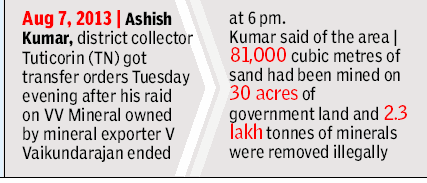
From: The Times of India 2013/08/11

From: The Times of India 2013/08/11
See graphics:
Taming officers who dare-I
Taming officers who dare-II
Taming officers who dare-III
Targetting journalists who dare
2015-17
Scindia Seeks CBI Probe; Cops Say Formed SIT, Interrogating Driver
A 35-year-old journalist investigating illegal sand mining cases in Bhind district of Madhya Pradesh was run over by a truck on Monday morning. Identified as Sandeep Sharma, the journalist was working with a regional news channel.
Police said they have formed an SIT team to investigate the case.
Sources said they have detained the truck driver and he is being interrogated.
The death has sparked off political slugfest with the Congress leader Jyotiraditya Scindia demanding a CBI probe into the case and chief minister Shivraj Singh jumping in to defend his government and assuring that safety of journalists would be ensured at all costs. The Bhind Press Club has also demanded an impartial probe in the case.
Sources said Sandeep had filed a complaint four months ago citing threat to his life from a police officer after a ‘sting operation’ against him. Sources said Sandeep had filed a story accusing the officer of being hand in glove with the sand mafias. An audio conversation of the officer in question was aired by his channel after which the officer was transferred, said sources.
Sharma’s two-wheeler was hit by the truck from behind killing him on the spot around 9 am, just a few meters away from the Kotwali police station. The truck was found abandoned a few kilometres away. A CCTV footage that surfaced within a few minutes of the crime shows Sharma riding a motorbike which vanishes under a truck that mows him down on a busy stretch in the Bhind town.
“CCTV footage shows the bike overtaking the dumper on the left and then turning to the right. Dumper driver would not have seen the bike till it swerved and came in front,” said a policeman wishing anonymity.
Sharma is survived by his wife and two children aged 14 and 15 years. Sharma’s death triggered a panic among other journalists in the region. It is alleged that police responded after 15 to 20 minutes despite the spot being a few meters from the police station.
W.B.: Since 2015 nearly 10,000 people have lost home
Bhagirathi-Hooghly
Romita Datta , Caught in the sand storm “India Today” 5/2/2018
Indiscriminate dredging along a 170 km stretch of the Bhagirathi-Hooghly in West Bengal cutting away the fertile alluvial topsoil along the riverbank has made life a nightmare in the villages of Nadia district. Already prone to soil erosion as six rivers crisscross the district, the spurt in activities of illegal sand and soil syndicates, which allegedly enjoy the patronage of leaders of the ruling Trinamool Congress, is now destroying villages. It has altered the topography of 94 gram panchayats, displacing thousands of families.
Residents say the syndicates have a stranglehold on the supply of building material-sand, gravel and bricks-which lets them keep prices exorbitantly high. They operate under the protection of local politicians and the police, and it doesn't even seem to matter that the payoffs to the police and politicians are a pittance compared to the huge profits they make lifting sand and soil from the riverbed for free. A medium-sized truck carrying some 350 sacks of sand or soil, for instance, fetches Rs 3,500.
Ajay Biswas, a resident of Poradanga, one of the worst-affected villages, says faced with protests from villagers, the syndicates are now transporting sand in tarpaulin-covered tractor-trollies, and even using boats to deliver soil to brick kilns in Burdwan.
It is estimated that some 10,000 people have lost their homes in the past three years as the river has become increasingly prone to breaking the banks during the monsoon. In Chakdaha municipality, the river has gone more than 2.5 km off its original course due to erosion of the riverbank. New islands have formed along the opposite bank in Hooghly and Burdwan districts.
Krishna Chandra Biswas, 85, has seen his home being washed away four times. He now lives with relatives in Poradanga. "I remember when it would take two hours to walk to the riverbank," he says, pointing to the water course, which is now a stone's throw from the village. The sand mafia does not let the displaced villagers settle on land that becomes available when the river shifts course. Shyamal Biswas, a villager, says he was evicted at gunpoint.
Locals claim even contractors working on government projects are forced to purchase building material from illegal syndicates. Local Congress leaders allege the administration refuses to act because the Trinamool Congress protects the syndicates.
See also
Sand mining: India
